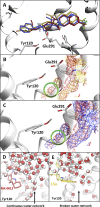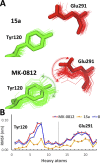Enhancing Drug Residence Time by Shielding of Intra-Protein Hydrogen Bonds: A Case Study on CCR2 Antagonists
- PMID: 30891134
- PMCID: PMC6421533
- DOI: 10.1021/acsmedchemlett.8b00590
Enhancing Drug Residence Time by Shielding of Intra-Protein Hydrogen Bonds: A Case Study on CCR2 Antagonists
Abstract
The target residence time (RT) for a given ligand is one of the important parameters that have to be optimized during drug design. It is well established that shielding the receptor-ligand hydrogen bond (H-bond) interactions from water has been one of the factors in increasing ligand RT. Building on this foundation, here we report that shielding an intra-protein H-bond, which confers rigidity to the binding pocket and which is not directly involved in drug-receptor interactions, can strongly influence RT for CCR2 antagonists. Based on our recently solved CCR2 structure with MK-0812 and molecular dynamics (MD) simulations, we show that the RT for this and structurally related ligands is directly dependent on the shielding of the Tyr120-Glu291 H-bond from the water. If solvated this H-bond is often broken, making the binding pocket flexible and leading to shorter RT.
Conflict of interest statement
The authors declare no competing financial interest.
Figures




Similar articles
-
Structure prediction and molecular dynamics simulations of a G-protein coupled receptor: human CCR2 receptor.J Biomol Struct Dyn. 2013;31(7):694-715. doi: 10.1080/07391102.2012.707460. Epub 2012 Aug 22. J Biomol Struct Dyn. 2013. PMID: 22909007
-
Receptor rigidity and ligand mobility in trypsin-ligand complexes.Proteins. 2005 Feb 1;58(2):407-17. doi: 10.1002/prot.20326. Proteins. 2005. PMID: 15578663
-
Evaluation of (4-Arylpiperidin-1-yl)cyclopentanecarboxamides As High-Affinity and Long-Residence-Time Antagonists for the CCR2 Receptor.ChemMedChem. 2015 Jul;10(7):1249-58. doi: 10.1002/cmdc.201500058. Epub 2015 Jun 1. ChemMedChem. 2015. PMID: 26033831
-
Theoretical aspects of the biological catch bond.Acc Chem Res. 2009 Jun 16;42(6):693-703. doi: 10.1021/ar800202z. Acc Chem Res. 2009. PMID: 19331389 Review.
-
Neutron Crystallography for the Study of Hydrogen Bonds in Macromolecules.Molecules. 2017 Apr 7;22(4):596. doi: 10.3390/molecules22040596. Molecules. 2017. PMID: 28387738 Free PMC article. Review.
Cited by
-
How Do Molecular Dynamics Data Complement Static Structural Data of GPCRs.Int J Mol Sci. 2020 Aug 18;21(16):5933. doi: 10.3390/ijms21165933. Int J Mol Sci. 2020. PMID: 32824756 Free PMC article. Review.
-
Inhibitor design for TMPRSS2: insights from computational analysis of its backbone hydrogen bonds using a simple descriptor.Eur Biophys J. 2024 Feb;53(1-2):27-46. doi: 10.1007/s00249-023-01695-4. Epub 2023 Dec 29. Eur Biophys J. 2024. PMID: 38157015 Free PMC article.
-
Comprehensive assessment of TECENTRIQ® and OPDIVO®: analyzing immunotherapy indications withdrawn in triple-negative breast cancer and hepatocellular carcinoma.Cancer Metastasis Rev. 2024 Sep;43(3):889-918. doi: 10.1007/s10555-024-10174-x. Epub 2024 Feb 27. Cancer Metastasis Rev. 2024. PMID: 38409546 Review.
-
The Impact of the Secondary Binding Pocket on the Pharmacology of Class A GPCRs.Front Pharmacol. 2022 Mar 9;13:847788. doi: 10.3389/fphar.2022.847788. eCollection 2022. Front Pharmacol. 2022. PMID: 35355719 Free PMC article. Review.
-
Molecular determinants of antagonist interactions with chemokine receptors CCR2 and CCR5.bioRxiv [Preprint]. 2024 Feb 12:2023.11.15.567150. doi: 10.1101/2023.11.15.567150. bioRxiv. 2024. PMID: 38014122 Free PMC article. Preprint.
References
-
- Katschke K. J.; Rottman J. B.; Ruth J. H.; Qin S.; Wu L.; LaRosa G.; Ponath P.; Park C. C.; Pope R. M.; Koch A. E. Differential Expression of Chemokine Receptors on Peripheral Blood, Synovial Fluid, and Synovial Tissue Monocytes/Macrophages in Rheumatoid Arthritis. Arthritis Rheum. 2001, 44 (5), 1022–1032. 10.1002/1529-0131(200105)44:5<1022::AID-ANR181>3.0.CO;2-N. - DOI - PubMed
LinkOut - more resources
Full Text Sources
Other Literature Sources

